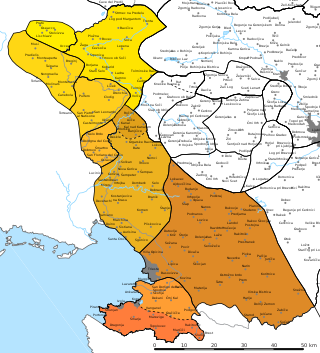User:Garygo golob/Istrian dialect/sandbox
| Istrian dialect | |
|---|---|
| ˈiːstərskȯ naˈriːečje | |
| Pronunciation | ˈiːstəɾskʊ͈ naˈɾiːɛt͡ʃi̯ɛ |
| Native to | Slovenia, Italy, Croatia |
| Region | Slovene Istria, mucipalities of Muggia and San Dorligo della Valle |
| Ethnicity | Slovenes |
Early forms | Southeastern Slovene dialect
|
| Dialects | |
| Language codes | |
| ISO 639-3 | – |
 Istrian dialect | |
This article uses Logar transcription.
| South Slavic languages and dialects |
|---|
The Istrian dialect (Slovene: istrsko narečje [ˈíːstəɾskɔ naˈɾéːt͡ʃjɛ],[1] istrščina[2]) is a Slovene dialect spoken in Slovene Istria, as well as some settlements in Italy[3] and Croatia.[4] Dialect borders Inner Carniolan dialect to the north and northeast, Southern Chakavian and Buzet dialect to the south, as well as Southwest Istrian to the southeast and Čičarija dialect to the east. The dialect belongs to the Littoral dialect group, and evolved from Lower Carniolan dialect plane.[5][6]
Geographical distribution[edit]
Dialect is spoken in Slovene Istria in most of the rural areas of the municipalities of Koper/Capodistria, Izola/Isola, Ankaran/Ancarano and Piran/Pirano, as well as by the Slovenes living in the Italian municipalities of Muggia/Milje and San Dorligo della Valle/Dolina, in the southern suburbs of Trieste/Trst (Servola/Škedenj, Cattinara/Katinara)[3][7] and Croatian villages of Slum and Brest.[4] Notable settlements include Koper/Capodistria, Izola/Isola, Ankaran/Ancarano, Strunjan/Strugnano, Piran/Pirano, Portorož/Portorose, Dragonja/Dragogna, Vanganel, Marezige, Dekani, Spodnje Škofije and Črni Kal in Slovenia and Muggia/Milje, Stramare/Štramar, San Dorligo della Valle/Dolina and Trieste/Trst in Italy.
Accentul changes[edit]
Istrian dialect lost pitch accent on both long and short vowels and Šavrin Hills subdialect lost differentiation between long and short vowels completely, while Rižana subdialect is in late stages of losing differentiation.[8] It had undergone *ženȁ → *žèna, *məglȁ → *mə̀gla, *visȍk → vìsok, *ropotȁt → *ròpotat,[9] and (partially) *sěnȏ / *prosȏ → *sě̀no / *pròso (e. g. ˈsiːenȯ).[10]
Phonology[edit]
Phonology is in many aspects very close to Inner Carniolan dialect, but in some features, it barely shows similarities with other dialects from Lower Carniolan dialect plane. The biggest change happened to *ě̄ and non-final *ě̀, which in Lower Carniolan dialect base diphthongized into eːi̯, but then monophthongized into ẹː in some dialects. In Istrian dialect, however, it diphthongized again, this time into iːe. Stressed *ę and *e turned into i̯eː. Stressed *ǫ turned into uːo or uːə. Short *ò turned into uː in all positions and *ō turned into uːo. Vowels *ù and *ū turned into yː, in the south also into uː, əː or u̯ə. In Šavrin Hills subdialect, diphthongs have monophthongized for the second time; *ě turned into ẹː, *e and *ę turned into eː.[8]
Newly accented *e turned into iːe in the north and to ä/ȧ in the south, newly accented *ə stayed ə in the north, but turned into ä/ȧ in the south. Newly accented *o turned into u̯ä in the south. Short accented *i and *u or if before the accented syllable turned into e. Final *o turned into ȯ, u or u̯ə, final *ǫ turned into u̯o and final *ę turned into i̯e.[8]
Velar *ł remained velar before central and back vowels. Second Slavic palatalization is still present for dorsal consonants in the north, k →t’/ć/č, g → j, x → ś/š. Syllabic *ł̥̄ turned into oːu̯ or uː. Consonant *g turned into ɣ in the north and palatal sounds remained, except *t’ might have changed into ć or č. Final *m turned into n.[8]
In villages of Kubed, Gračišče, Hrastovlje, Dol pri Hrastovljah and Zazid, dialects lack first monophthongization for *ě, so it is still pronounced as *eːi̯, and turn of iːe → i̯eː.[11]
Morphology[edit]
Preposition pri is used with genitive instead of locative.[12] Apart from that, morphology is poorly researched, but is probably close to Inner Carniolan dialect.
Subdivision[edit]
Istrian dialect is split into two subdialects; northern, more archaic Rižana subdialect and southern, more influenced by Croatian Šavrin hills subdialect. Main differences are monophthongization and loss of length differentiation in Šavrin hills dialect.
References[edit]
- ^ Smole, Vera. 1998. "Slovenska narečja." Enciklopedija Slovenije vol. 12, pp. 1–5. Ljubljana: Mladinska knjiga, p. 2.
- ^ Rigler, Jakob. 2001. Zbrani spisi: Jezikovnozgodovinske in dialektološke razprave. Ljubljana: Založba ZRC, p. 232.
- ^ a b "Karta slovenskih narečij z večjimi naselji" (PDF). Fran.si. Inštitut za slovenski jezik Frana Ramovša ZRC SAZU. Retrieved June 8, 2020.
- ^ a b Šekli (2018:374–377)
- ^ Logar, Tine; Rigler, Jakob (2016). Karta slovenskih narečij (PDF) (in Slovenian). Založba ZRC.
- ^ Šekli (2018:335–339)
- ^ Toporišič, Jože. 1992. Enciklopedija slovenskega jezika. Ljubljana: Cankarjeva založba, pp. 63, 257, 321.
- ^ a b c d Logar (1996:88–91)
- ^ Šekli (2018:310–314)
- ^ Logar (1996:89)
- ^ Logar (1996:89–90)
- ^ Logar (1996:88–89)
